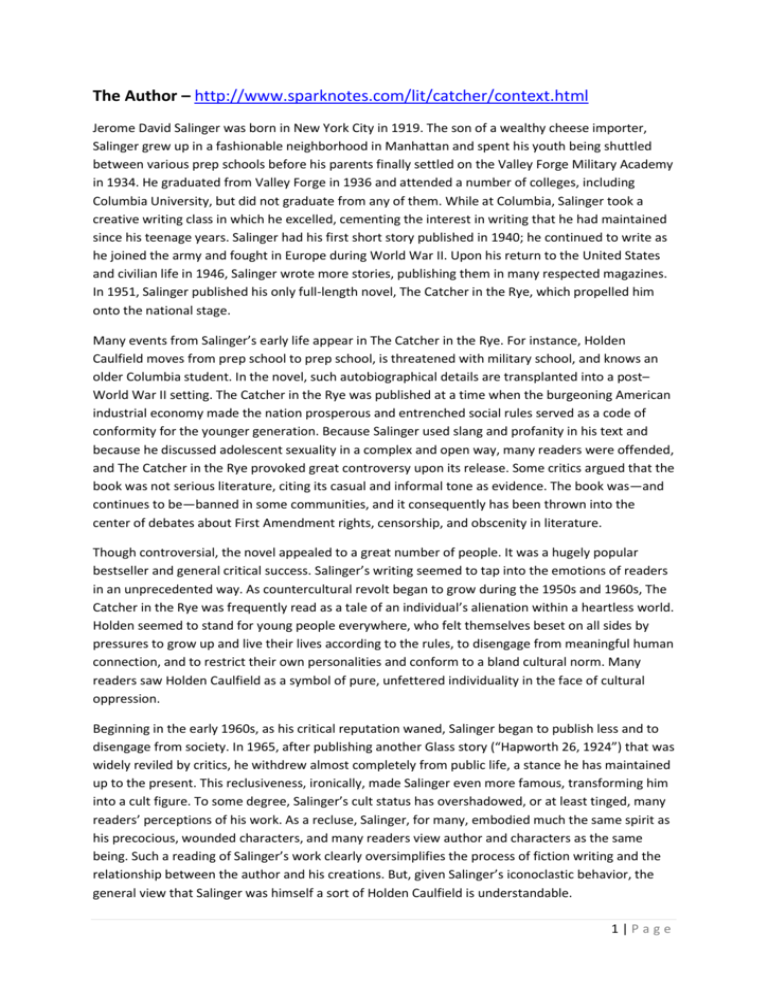
These words are Holden’s way of making sense of the world and calming himself in times of terrible stress and anger. The glove is covered in poetry handwritten in green ink. There is a distressing scene in the novel in which Holden’s roommate, Ward, speaks dismissively about a composition Holden wrote in regard to the glove. Tied intimately to the themes of youth and mortality, the baseball glove symbolizes the love he has for his younger brother and the anger he felt at his death. Symbols in The Catcher in the Rye Allie’s Baseball Glove His words and thoughts run together, one after another as if there is no pause between him thinking something and saying it. There is also a stream of consciousness elements in the novel. A reader shouldn’t trust that everything Holden says is the truth or is a fulsome depiction of events or people. This means, considering holden’s state of mind at the time and in the present as he’s speaking, that he’s an unreliable narrator. In a sarcastic and judgmental tone, he tells his own story, looking back on the past. Salinger provides the reader with Holden’s first-person perspective in the novel. These words stand in stark contrast to the “phony” adult world Holden is so opposed to. Holden uses words like “flitty” to refer to gay men, frequently curses, and uses colloquialisms such as “pretty as hell”. As well as one of the main reasons the novel was rejected by critics when it was first published. The first, slang, is a prominent feature of Salinger’s writing in this novel. These include slang, narrative point of view, and symbolism. Salinger makes use of several literary devices in The Catcher in the Rye. Style, Literary Devices, and Tone in The Catcher in the Rye The novel ends with Holden narrating his present.He takes her to the zoo and pays for her to ride the carousel.Holden decides to run away and meets phoebe for what he thinks is the last time.Antolini’s house but leaves after feeling uncomfortable.


He sneaks into his own house to talk to his sister, Phoebe.After getting drunk, he annoys another acquaintance, Carl Luce.He makes a date with Sally Hayes, they go to the movies and ice skating.The elevator operator sends a prostitute to Holden’s room, it doesn’t end well.Eventually, Holden goes to a jazz club and sees one of his older brother’s ex-girlfriend.Holden tries to find someone to have sex with and fails.He encounters the mother of one of his school mates on the train.Holden storms out of school and takes the train to Manhattan.He confronts Ward about his date with Jane.Death was something ever-present and on everyone’s mind.Īnalysis of Key Moments in The Catcher in the Rye A reader should also consider the time period in which the novel is meant to take place, the 1950s, post-WWII. He admits to respecting this boy’s choice. Holden doesn’t fear death, at least when he sees it through the eyes of this student. A young boy, cornered in a room by bullies, jumped out the window rather than be attacked. There was also a past memory of a suicide he witnessed at one of his schools. It is a consent part of his life, from when his younger brother died of leukemia before the novel began. These kids act in a particular way and take advantage of their privilege.ĭeath is a topic that’s always on Holden’s mind. Despite the different schools, he’s been to, they’ve all been for the upper class, rich kids. This is in part due to the consistent circle of similar peers he ends up in. Everyone around him is shallow, irritating, and distasteful. Holden feels as though it’s impossible for him to find someone he relates to, aside from Jane who he met years before the novel started. Or, most obviously, there is his desire to run away from his life, a solution that solves no problems.

He consistently gets kicked out of school and when he’s annoyed he gets angry and rejects other people. This can be seen through his interactions with the teachers and the way he shrugs off and even grows angry at their advice.Īdditionally, Holden’s behavior should be read as a consistent rejection of maturity and the process of aging. He has a persistent fear of growing old and finds all the adults in his life to be fake and annoying. Throughout the novel, the reader is given examples of Holden’s preference for children over adults and youth over aging. It is a desire for youth, fear of aging, appreciation for death, habitual isolation, and desire for a company that bog down the young man’s mind and help make The Catcher in the Rye the much-loved novel that it is today. These themes touch on the most important parts of the protagonist, Holden Caulfield’s personality and tortured mental state. Salinger’s only novel, The Catcher in the Rye. From youth to isolation and mortality, there are a myriad of themes in J.D.


 0 kommentar(er)
0 kommentar(er)
